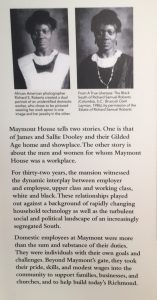by Catherine Franceski
As I walked through Maymont’s gates on a balmy summer morning, I imagined that I must have felt exactly as many visitors did around the turn of the 20th century– full of awe and wonder. Today, Maymont encompasses a Gilded Age mansion, a petting zoo, and extensive gardens and grounds. Acquired in 1886 by James and Sallie May Dooley, Maymont, an 100 acre estate on the banks of the James River, was undoubtedly one of the largest properties owned in Richmond. James Dooley was a confederate major in his youth and later became a prominent lawyer and businessman. His wife, Sallie, grew up on a Virginia plantation and later wrote “Dem Good Ole Days,” a collection of short works glorifying the Antebellum period written from the perspective of an enslaved person. The couple, having no heirs, donated Maymont to the city of Richmond after Sallie’s death in 1925.
The Dooleys lived at Maymont post-Civil War, meaning there were no enslaved persons, and the property never functioned as a plantation. The Dooleys did, however, employ mostly African-American domestic workers, such as cooks, landscapers, maids, and butlers who were vital to the upkeep and functioning of the estate. The mansion itself required seven to ten workers at any given time while the surrounding property required about 22 landscapers to keep the grounds manicured and in perfect shape. However, these vital staff who were the heartbeat of the estate, were not mentioned on the tour except in conjunction with the services they provided to the Dooleys while working in the house. For example, the workers were mentioned while pointing out a button in Sallie’s suite that was used to call the butler. The daily life and activities of the employees were left out entirely from the tour.
After further research online, I learned that the basement door that we entered to register for the tour was the servants quarters and area. Right where we entered I had noticed a mounted placard showing a picture of one of the former domestic workers with the words, “Maymont House tells two stories. One is that of James and Sallie Dooley and their Gilded Age home and showplace. The other story is about the men and women for whom Maymont house was a workplace. For thirty-two years, the mansion witnessed the dynamic interplay between employer and employee, upper class and working class, white and black.” The accompanying photograph was the most powerful thing I saw at Maymont that day. The photograph was of an unidentified domestic worker who chose to be photographed two ways. In one portrait, she is seen in her work clothes, wearing an apron. In the other picture, she is seen in her jewelry, not as a worker.

The inclusion of this image was powerful for being able to see the employees beyond their work duties and expanding the narrative of their personhood to their personal goals and ambitions. They were real people with real lives. In a way, this reminded me for a second of our own UR campus. We take so much pride in our campus and are quick to brag about how beautiful it is. Except, we students do not commonly interact with or thank the landscapers who create this beautiful place. On the flip side, I’ve seen seen students go long and far for workers that are more “convenient” to talk to. For example, my freshman dormitory raised money for the person who cleaned our bathrooms whose grandson was killed by a drunk driver. Her grandson had two younger children who were now going to be in her care, and she would have to shoulder most of the financial burden. This came about from a normal conversation one student had with the cleaning person, just like the conversations many of us have everyday with d-hall employees and other maintenance staff. Still, we students could do a better job remembering the more “hidden,” but equally important, employees. Sometimes the beauty is not in the final product or facade, but in the people and processes that go into creating it.
In many ways the employees responsible for the upkeep were just as important as the estate itself. I appreciated Maymont’s effort to remember the staff who worked at the estate and their role in creating and maintaining this beautiful piece of land which thousands of visitors still enjoy and admire today.
Catherine Franceski is a rising sophomore at the University of Richmond majoring in Philosophy, Politics, Economics & Law. She is working on the Race & Racism Project in partnership with Untold RVA during Summer 2017 as an A&S Summer Fellow.

Thank you for your thoughtful consideration in this piece. It reminded me to look from another perspective.